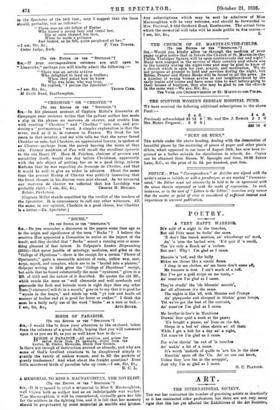ART.
THE INTERNATIONAL SOCIETY.
Tax war has contracted the number of practising artists as drastically as it has contracted other professions, but there are not very many signs that this has yet affected the Exhibitions of the Art Societies,
which continue in scale and setting to be the [same as-ever. People in big towns are subletting their houses and reducing the scale of their establishments, and relatives in many cases are combining to live together to decrease their housekeeping expenses. It might be a good plan if our Art Societies were to reduce the number of their exhibits and combine in collective Exhibition's. The number of pictures worth exhibiting can hardly remain the same when the most vigorous part of each Society is in the Army ; and the result of holding to the old system is that the quality of Exhibitions grows thinner and thinner, and the interest of the public, which has less and less time to spare for art, is in danger of quietly fading away. It would be easy to suggest many " happy families " that might be organized for one such show- ground, as, for instance, the Grafton Galleries, and the piquancy of such arrangements would increase the visitors. The artists would save to the extent of frames and mounts and other expenses—and might save, too, in reputation. The autumn show of the International Society at the Grosvenor Gallery is not more a case in point than many other Exhibitions—perhaps not so much—but it certainly shows considerable intervals between interesting pictures. Mr. John Lavery, who, at a time when so many painters are adventuring further into phantasies and generalized humanity, is becoming an illustrator of contemporary life, has a sketch of Hyde Park in sunshine, with convalescent soldiers resting near the Achilles statue, whioh he entitles The Heel of Achilles. Mr. William Orpen (who is now in the A.S.C.) is represented by an amusing exercise widish he painted as a student at the Slade SchooL He calls it The Play Scene in " Hamlet" (No. 27). It is a sort of bacchanal in a theatre, full of brilliant, equivocal parodies of the minor masters for the enjoyment of the connoisseur. It is, perhaps, the most racy and amusing thing that Mr. Orpen has done, and shows a power of picture-making which is often absent in his maturer work. Mr. William Strang has-a rather bored picture, The Decoration of Ceres (No. 46), and an arresting portrait, Panchita Zorolla (No. 47), with that bare, " thrawn" attractiveness with which this artist has plainly hinted that some day or other he will produce a masterpiece. Mr. James Pryde's Red Ruin (No. 60) has not sufficient quality to justify its size, but it is a grandiose idea that deserves to be seen at its best. Mr. D. Y, Cameron, Mr. Oliver Hall, Mr. Charles Ricketts, Mr. Walter Sicked, Mrs. Laura Knight, Mr. A. J. Munnings, and Mr. Glyn Philpot help to sustain the interest of the show. Mr. Ambrose McEvoy in his series of pale and delicate portraits of aristocratic ladies gives us what is almost a form of flower-painting. There is a good supply of drawings and prints. J. B.



































 Previous page
Previous page